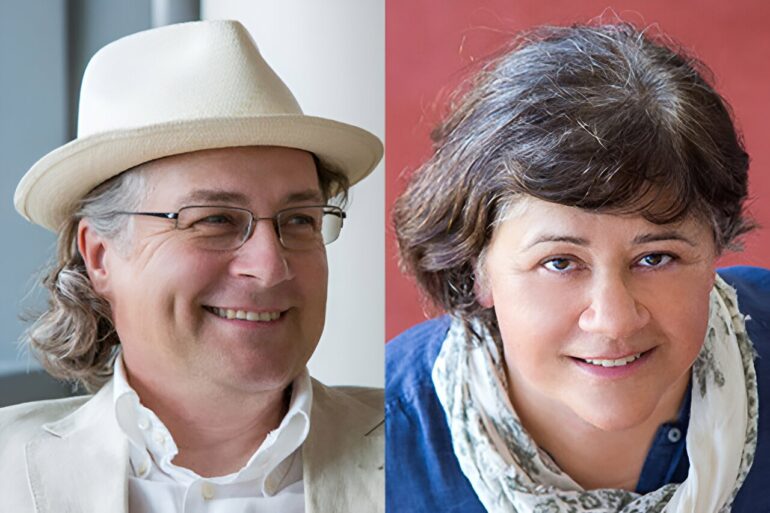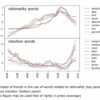What’s the winning number for next week’s Mega Millions? If Julie knew the number, Leah would know the number.
But you know that neither person holds this precious secret—and not just because Mega Millions hasn’t been drawn yet. You know because you understand the implication of the sentence, even though it is free of any “not,” “no,” or other form of negation.
How you understand sentences like this—how you make what linguists call a “counterfactual inference”—is the fruit of a 30-year professional partnership between Kai von Fintel, the Andrew W. Mellon Professor of Linguistics, and Sabine Iatridou, the David W. Skinner Professor of Linguistics.
Their new paper, “Prolegomena to a theory of X-marking,” published in Linguistics and Philosophy, offers a fresh take on one of the most distinctive properties of human language: our capacity to talk about hypotheticals, and on how and why the forms that are used in some such hypotheticals appear elsewhere in language with different results.
Consider this slightly diverging alternative sentence: “If Julie knows the answer, Leah knows the answer.” No implication here that Julie and Leah do not know the answer. So how is it that we make the counterfactual inference for the first sentence but not the second?
To start, von Fintel and Iatridou explain that the first sentence has an extra past tense morpheme: both in the if-clause “if Julie knew” … and in the consequent clause “Leah would know” (linguists unpack the word “would” as “will + past tense”). Yet we don’t interpret this morpheme (a unit of language that is both meaningful and indivisible) as being about the actual past. For example, “If Julie knew the answer now, Leah would also know it right now” is not at all about the past, but still conveys the counterfactual inference.
Some languages, such as Hungarian, accomplish this by using a specialized morpheme that has no other function. Other languages use a morpheme or combination of morphemes that have other functions as well. As a unified name, von Fintel and Iatridou use the term “X-marking” for the marking on counterfactuals. “X stands for extra, an X factor that is mysterious,” says von Fintel.
“The paper offers a bold and groundbreaking way of re-framing a fascinating contrast that permeates how natural languages allow us to talk about hypothetical states of affairs,” confirms Magdalena Kaufmann, an associate professor of linguistics at the University of Connecticut who was not involved in the work.
Beyond if/then
Extending the scope of their investigation, looking across many languages, the MIT team discovered that X-marking has at least two other functions. One is creating counterfactual wishes: “She wishes she had a brother now” clearly signals that she does not have a brother, even though the sentence is free of negation words.
Note the X-marking, in the form of a non-temporally interpreted past morpheme, on “had a brother now.” Moreover, in other languages there’s no word “wish;” instead what is used is “want + X” (for example, in Greek, French, and several non-Indo-European languages).
But wait—there’s more. In many languages X-marking also serves to distinguish “must” from “ought”—i.e., separating the “strong” necessity of “must,” or “have to,” from the “weak” implication of “ought.” That is, many languages do not have a verb “ought,” but instead use “must + X.” In English, we might say “You ought to read the rest of this article, but you don’t have to.” Reporters in many other languages would say “You must + X read the rest of this article but you don’t have to.”
The fact that X-marking has these multiple functions in so many different languages says something deep about human language. “Unfortunately, what this is exactly we do not yet know,” the researchers acknowledge. “The point of this paper is to say look, why is there X-marking that can turn a conditional into a counterfactual, a strong necessity into a weak necessity, and a desire into unattainable desire?” says Iatridou. “What meaning are we going to give to X so that it can do these three different jobs?”
Remarks von Fintel, “This fairly particular phenomenon is widespread, and trying to understand and explain it is a real puzzle.”
“We look at similarities that cannot be explained as a result of language contact over the years,” says Iatridou. “Our premise is that if unrelated languages have something in common, that means something deep about how the human brain produces and codes meanings.”
Toward a unified theory of X-marking
With a cohort of graduate assistants and colleagues acting as “informants”—native speakers of other languages skilled in finding analogs to X-marking statements presented by von Fintel and Iatridou—the researchers hope to track their morphemes in more locations around the world. They have been working on a cluster of data in Turkish, Hindi, and Farsi, according to von Fintel—forays that may reveal new and unusual forms of X-marking.
Both researchers see this paper, decades in the making, as an invitation to fellow linguists to contribute to a unified theory of X-marking, “an area of language where humans move away from talking about the actual here-and-now and think about possibilities, necessities, and hypotheticals,” says von Fintel. “Thinking and communicating that allows us to get away from the present is absolutely essential.”
Their research is already making an impact. “If what I propose in my recent research about necessity modals in Brazilian Portuguese is on the right track, then certain instances of these modal verbs can be analyzed as X-marking,” says Marcelo Barra Ferreira, an associate professor of linguistics at the University of Sao Paolo, Brazil. “This is something which was not obvious to me before knowing their work.”
Kaufmann adds, “The paper is unparalleled in its combination of discussing previous theoretical research in the philosophical and linguistic literature, while also exploring the relevant contrasts in a significant number of related and unrelated languages. By overcoming the stifling traditional terminology, uncovering a fascinating and cross-linguistically stable pattern, and proposing ideas for a unified analysis, the paper has already begun to spur a wealth of new research and is certain to continue to do so.”
“We don’t have the final, complete theory, but we are hopefully presenting the right questions,” says Iatridou.
More information:
Kai von Fintel et al, Prolegomena to a theory of X-marking, Linguistics and Philosophy (2023). DOI: 10.1007/s10988-023-09390-5
Provided by
Massachusetts Institute of Technology
This story is republished courtesy of MIT News (web.mit.edu/newsoffice/), a popular site that covers news about MIT research, innovation and teaching.
Citation:
Speaking hypothetically: Linguists explore how human language handles leaps from the here and now (2023, August 23)



